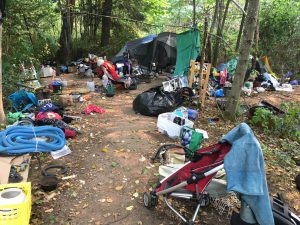COMOX VALLEY, B.C. – Wildfire smoke is a relatively new challenge for Comox Valley’s and Campbell River’s homeless populations, and a local homeless advocate is doing her best to do something about it.
Sarah Sullivan is the lead of the AHERO (Ad hoc Emergency Response Organizations) and has been the head of this conversation as of late.
Sullivan sent inquiries to City of Courtenay council and an email to the church community to see if they can secure a safe, welcoming space where homeless people can go to find respite from the smoke.
“Those inquiries have been made but I haven’t heard any news back,” Sullivan said. “This is not going to be a one-time event as we are all hearing. This is being considered the new normal. It would be wise and compassionate for the community to come up with a strategy for how folks who do not have homes, can get out of the smoky conditions.”
Places like the Courtenay Library and community centres are not designated to have people stay for long periods of time, Sullivan said.
“We really do need a coordinated official, policy and organized approach,” Sullivan said.
For the past couple of years, Sullivan has chaired AHERO, an adhock group that has existed for more than three decades and is made up of social services agencies, faith groups, and concerned citizens who strive to identify any gaps for people living in poverty and advocate for possible solutions.
Sullivan said members of the Comox Valley’s homeless population have been telling her that over the past few days, they were having trouble breathing in the smoke.
“Many of the people that we work with have chronic diseases and pre-existing health conditions, and so the smoky conditions are making it very challenging for them,” she said.
The Extreme Weather Protocol in the Comox Valley is exclusive to extreme cold weather, and is in place from 8 p.m. to 8 a.m., and Sullivan said the local Salvation Army shelter has beds available to help the homeless overnight.
However, midday, when the heat and the smoke are at their most intense, “is an issue,” Sullivan said.
“I know for example in some communities where there is extreme heat, there are cooling centres set up,” she added. “To me, that would be a model that possibly could be looked at, is would there be something similar that we could do during the smoky conditions.”






